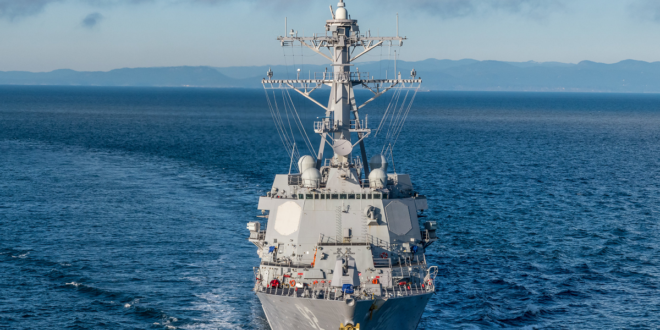The top U.S. military officer is warning of a growing arms race in the western Pacific, as nations become increasingly concerned about China’s military buildup in the region following Russia’s invasion of Ukraine.
“There’s a really an underreported arms race going on in the western Pacific right now. These countries are arming themselves up, and they very much, with very few exceptions, want the United States there,” Gen. Mark Milley, the chairman of the Joint Chiefs of Staff, told members of the Senate Armed Services Committee on Tuesday.
Australia this month unveiled a $200 billion plan for nuclear-powered submarines. Japan has also increased its offensive capabilities and doubled its defense investments, all while announcing new deployments of U.S. troops on Japan’s southern islands that will bring with them mobile anti-ship missiles meant to counter any first strike from Beijing.
Meanwhile, Beijing has asserted its desire to control access to the South China Sea and bring Taiwan under its control, by force if necessary. Milley said China was “trying to become the regional hegemon,” disadvantaging other countries like the Philippines as part of that effort.
“That’s why the secretary traveled to the Philippines. That’s why we’re looking at access basing and oversight. That’s why we’re looking at a re-posturing in the western Pacific. It is a design there to be forward deployed in order to deter armed conflict with a great power, great power being China in this case,” Milley said.
In February, the Philippines designated four additional bases for U.S. forces to operate in. The announcement marked a sharp turn back toward the United States, after former Filipino President Rodrigo Duterte had distanced himself from Washington.
“Two years ago, we were about to get kicked out of the Philippines,” Defense Secretary Lloyd Austin said.
The U.S. has continued to expand its military partnerships with South Korea, Japan, the Philippines, Thailand, Australia and others in hopes of keeping international waterways open and building what officials, including Milley, have called a “strategic advantage over China.”
But Republican lawmakers Tuesday sharply criticized the Pentagon’s proposed budget as inadequate, especially in the Pacific region.
“For the third year in a row, President [Joe] Biden has sent to Congress a budget request that cuts military spending amid a more dangerous and complex threat environment,” said the committee’s ranking member, Senator Roger Wicker of Mississippi.
“This year’s budget is the last one that funds capabilities that are likely to be fielded before 2027. That’s the year by which [Chinese President] Xi Jinping says he wants the People’s Liberation Army to be ready to take Taiwan. That makes our work here very urgent,” he warned.
Senator Dan Sullivan of Alaska questioned the budget cuts at a time that Milley and Austin agreed was the most dangerous since World War II.
“This current budget shrinks the Army, shrinks the Navy, shrinks the Marine Corps. Doesn’t that embolden … Xi Jinping and Putin, not deter them?” asked Sullivan.
Milley said the budget represents “essentially a one-war strategy” that focuses resources on the Navy and the Air Force, the two military branches the Pentagon says are most needed in a potential fight with China.
He said the Navy would indeed decrease its hull numbers in the short term in order to shed some ships that are “costing way more money just to repair than worthwhile,” but would submit a shipbuilding plan with the number of ships increasing “in the not too distant future.”
Iran
Following the deadly attack at a coalition base in Syria by Iranian-backed forces last week, Austin told senators that Iran or its proxies have carried out 83 attacks on U.S. forces in the Middle East since President Biden took office in 2021.
The United States has retaliated by launching four major strikes against the attackers.
The Iranian attack on Thursday killed a U.S. military contractor and wounded five soldiers and another contractor. The U.S. fired back with “precision” strikes against facilities of Iran’s Islamic Revolutionary Guard Corps in the area, which the secretary confirmed had “people,” presumably militants, inside during the attack.
But Iranian proxies were not deterred, launching another attack on U.S. forces hours later that injured a U.S. citizen. The U.S. has “not yet” responded to that attack, according to Austin.
“What kind of signal do we think this sends to Iran when they can attack us 83 times since Joe Biden has become president, and we only respond to four? Maybe it’s because they know that until, that we will not retaliate until they kill an American, which emboldened them to keep launching these attacks which kill Americans,” Senator Tom Cotton said during the hearing.
The United States has about 900 troops in eastern Syria to help Syrian Kurdish forces prevent a resurgence of the Islamic State terror group.
Ukraine
Austin repeated the U.S. vow to “support Ukraine’s defense for as long as it takes,” praising Ukraine’s fighters for having the upper hand against the Russians and “depleting their inventory of armored vehicles in a way that no one would have ever imagined.”
But the top Pentagon leaders were blunt in their pushback against calls to provide F-16 fighter jets and MQ-9 drones to Ukrainian forces.
Austin said F-16s are a capability that would take about 18 months to provide.
“That won’t help them in this current fight,” he said.
Chairman Milley, when asked about whether Ukraine should receive MQ-9 drones, responded, “It’s not survivable. It’s big and slow. It’s going to get nailed by the Russian air defense systems.”
 Eurasia Press & News
Eurasia Press & News



